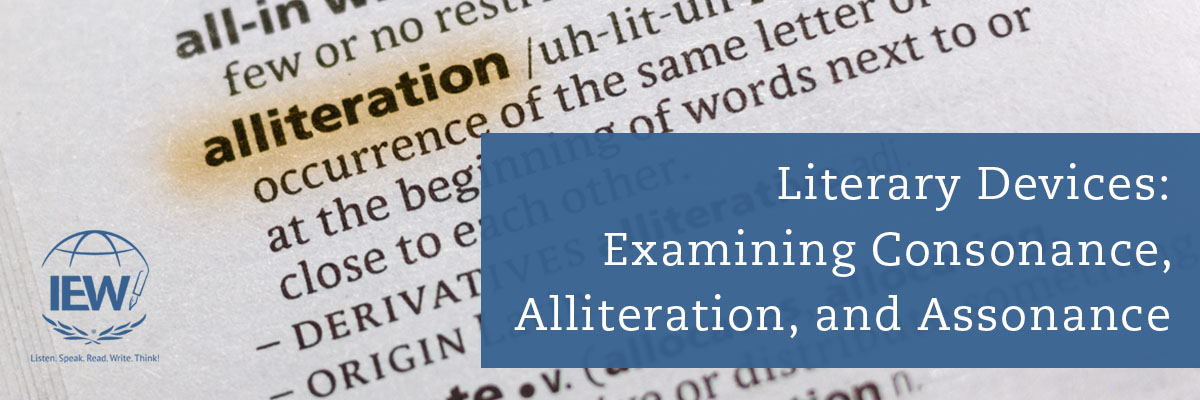In prior posts we have examined onomatopoeia as well as similes and metaphors. Today we will investigate three more literary devices: consonance, alliteration, and assonance. In the sample poems, the devices are underlined to make them easy to spot.
Consonance is a broader category under which alliteration fits. Consonance (a related term is consonant) refers to repeating consonant sounds in neighboring words. The words might have differing vowel sounds. The consonant sounds can appear anywhere within the word although they most typically come at the end. Examples of consonance include the following: lock pick, younger sister, stumble through brambles, and taken and wrecked. Read the beginning lines of Robert Frost’s poem “Out, Out—”:
Out, Out—
The buzz saw snarled and rattled in the yard
And made dust and dropped stove-length sticks of wood,
Sweet-scented stuff when the breeze drew across it.
And from there those that lifted eyes could count
Give mountain ranges one behind the other
Under the sunset far into Vermont.
Out of all of the literary devices available to a writer, perhaps the most popular now is alliteration. Alliteration, a type of consonance, is crafted by using the same initial consonant sound in short succession and is commonly employed across both poetry and prose. At one time alliteration was considered a required component in Germanic poetry, including Old English and Old Norse, as well as in Celtic verse (Baldick 8). Today, however, it is just one more fabulous tool available to writers, including Structure and Style students, who will note its mention on the checklist in regards to the various decorations.
Generally speaking, alliteration is most effective when used sparingly. For students of Structure and Style, the requirement is that there be three words that utilize it. There are many excellent examples of alliteration in literature and poetry. Here is Romantic poet Lord Byron providing an example in this famous piece of poetry:
She Walks in Beauty
She walks in beauty, like the night
Of cloudless climes and starry skies;
And all that’s best of dark and bright
Meet in her aspect and her eyes;
Thus mellowed to that tender light
Which heaven to gaudy day denies.
One shade the more, one ray the less,
Had half impaired the nameless grace
Which waves in every raven tress,
Or softly lightens o’er her face;
Where thoughts serenely sweet express,
How pure, how dear their dwelling-place.
And on that cheek, and o’er that brow,
So soft, so calm, yet eloquent,
The smiles that win, the things that glow,
But tell of days in goodness spent,
A mind at peace with all below,
A heart whose love is innocent!
Whereas consonance and alliteration focus on the consonant sounds in words, assonance instead centers on the vowel sounds. Note, however, that assonance is not the same thing as rhyme because the consonants differ. Some brief examples of assonance include “hit or miss,” “pale shade,” and “bright smile.”
William Blake composed this brief but rich poem, which serves as a capital example of assonance. (By the way, did you catch the use of both assonance and consonance in “capital example”?) Take a look at the first stanza below:
Ah! Sun-flower
Ah Sun-flower! weary of time,
Who countest the steps of the Sun:
Seeking after that sweet golden clime
Where the travellers journey is done.
It is very common for poets to combine all three elements of consonance, alliteration, and assonance into the same poem. Go back and reread the examples in this post, and see if you can identify any of the other techniques. They each include all three. Additionally if you own Linguistic Development through Poetry Memorization, you might enjoy putting on your sleuthing hat to discover other poetic examples of these literary devices. For a free introduction to the course, visit IEW.com/free-poetry.
Work Cited
Baldick, Chris. Oxford Dictionary of Literary Terms. Oxford University Press, 2008, New York.
|
Jennifer Mauser has always loved reading and writing and received a B.A. in English from the University of Kansas in 1991. Once she and her husband had children, they decided to homeschool, and she put all her training to use in the home. In addition to homeschooling her children, Jennifer teaches IEW classes out of her home, coaches budding writers via email, and tutors students who struggle with dyslexia. |


